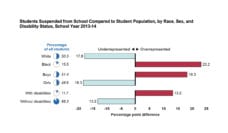In education, persistence and grit are thought to be key behaviors African American and Latinx students need to be successful as they learn. Recent research examining the psychological and physiological cost of persistence and grit indicates historically underrepresented students who are successful because of these behaviors pay a tremendous price that is often felt years later.
The ill effects of persistence of “pushing through” educational barriers is known as John Henrysim. John Henryism, is vernacular for a specific coping strategy, arising from chronic stress and challenge. The story of John Henry is that of a Black man who managed to lay railroad rails faster than a steel driving machine. In persisting through the difficulties, overcoming the challenge, and beating the machine, John Henry perished.
Educators are constantly asking our African American and other under-represented students to overcome systemic racial barriers and to influence their environment through tenacity and determination. This leads to trauma-like effects for these students. These effects can manifest as high blood pressure, heart disease, and other stress related outcomes.
Over the last year we have researched the negative negative effect of John Henrysim on Black and Brown college students in a post-baccalaureate medical program. Many African American students taking part in programs at predominately White institutions report feelings of isolation. Psychological allostasis and chronic stress, caused by the perception of a racially hostile environment, threatens academic success and psychological well-being of traditionally underrepresented students.
While all student groups have similar strategies for coping with general perceived stress, historically underrepresented students experience higher levels related to their minority status.
This perception of discriminatory treatment manifests as uncertainty of belonging and can invoke stereotype threat. Stereotype threat is the pervasive concern of affirming negative stereotypes ascribed to a non-dominant group. Perceived racial discrimination within an educational landscape reduces social connectivity and cultivates a skewed sense of academic self-concept that impedes trust and social interactions. In response to negative stereotypes, African Americans may adopt a “prove-them-wrong” attitude to overcome the stereotype.
While all student groups have similar strategies for coping with general perceived stress, historically underrepresented students experience higher levels related to their minority status. Much of our work illustrates that race and ethnicity are predictors of exposure to increased stress which impedes academic success. The psychological distress results from prolonged use of coping strategies which involve heroic efforts to overcome racial discrimination.
The methods used in the design of our study combine survey and clinical history taking with physiological outcomes. Our goal was to develop a profile of physiologically measurable outcomes in urban postsecondary students studying science, technology, engineering, and medicine that can be used in future research.
We identified three physiological measurements–blood volume pressure, heart rate variability, and electrodermal response–that consistently illustrate in conjunction with stress screenings the presence of chronic stress which remains even years after the student has completed the academics. According to the Trauma Symptom Checklist 40 (the screening tool), the three areas in which students scored most highly, where anxiety, depression, and dissociation. All are significant indicators of chronic stress.
These findings advance the conversation surrounding the concept of persistence and grit of historically underrepresented college students who negotiate the postsecondary landscape. They also provide educators with new methodological approach to examining the part that grit and determination play in the development of chronic stress and trauma. In essence, we are able to explore more deeply the impacts of chronic stressors upon the whole student.
Future studies should examine more specifically how blood volume pressure, heart rate variability, and electrodermal response in Black and Brown students are affected by anxiety, depression, and dissociation. This will allow us to identify a more specific profile of environmental stressors leading to psychological health concerns and long-term health problems.
Photo by Daniel Watson on Unsplash















